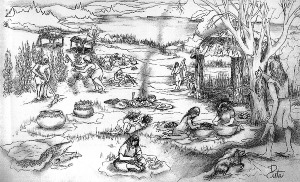
After the Mississippians settled in Wisconsin, other groups of Indians began living in Wisconsin. Between 1000 AD and 1630 AD, a group of Indians that the archaeologists called Oneota lived along the Waupaca River. They were the ancestors of the Ho-Chunk and other Indian nations.
The Oneota settled in large villages in southern Wisconsin. They often lived near large bodies of water, such as the Mississippi River and Lake Michigan, but also lived next to smaller rivers. The Dombrowski Site is one of several small Oneota villages found along the Waupaca River in Portage County in the Central Plain. They were excellent farmers: cultivating corn, beans, and squash. The three vegetables were named the “three sisters” by many Native Americans. The “three sisters” grew well together and made for a well-balanced diet.
The Oneota built houses different from the Mississippians. Some houses at the Dombrowski Site and other places could hold only one family. Big families would fit in longhouses that the Oneota also built.
Many native people who lived over 1,000 years ago communicated by using the side of the cliffs to leave messages about their history, beliefs, and traditions for generations to come. Another method was to create huge animals or spirit shaped effigy mounds out of dirt. They would also communicate by tattooing their bodies, adding designs to their clothes, hairstyles, and pottery work.
It’s amazing to think about how people lived back then. Today, there are places where you can still see large sites for rock art at Roche-A-Cri State Park in Adams County. Long ago, Indians carved messages and painted small figures on the sandstone of large cliffs at Roche-A-Cri.
[Source:
Wisconsin’s First People
]

